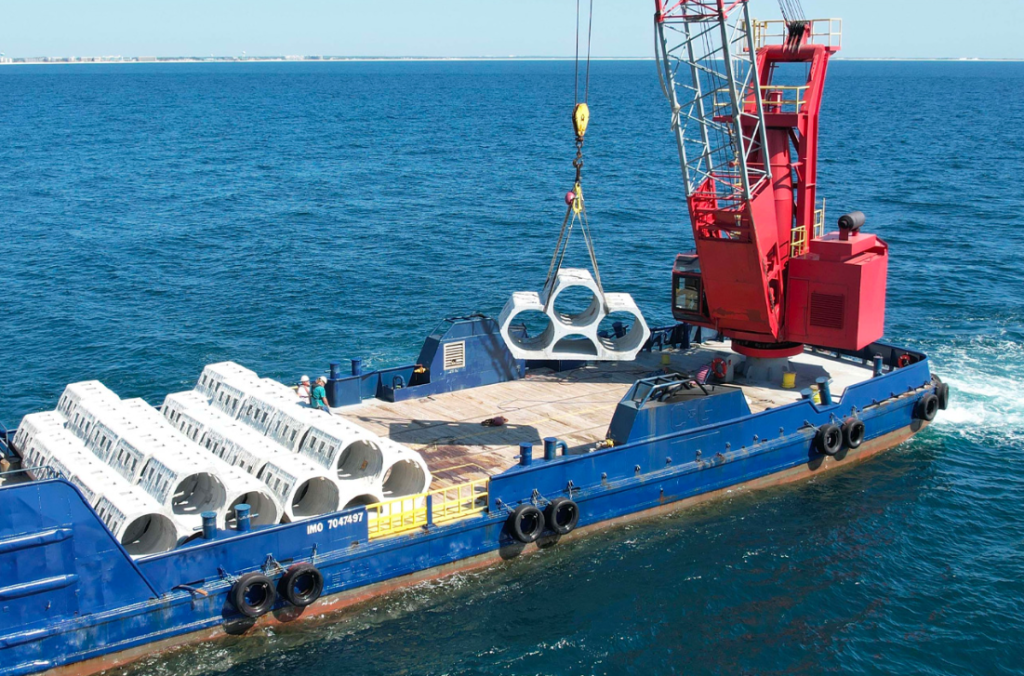3D printed artificial reefs have been deployed off the coast of Destin-Fort Walton Beach in a bid to aid marine habitat restoration and conservation efforts.
Managed by the Okaloosa Coastal Resource Team, this project saw the sinking of 25 concrete modules to the Gulf floor, creating new marine ecosystems at depths ranging from 60 to 90 feet. Funded by a $1.26 million grant from the Florida Fish and Wildlife Conservation Commission, this initiative is a part of the Natural Resource Damage Assessment Artificial Reef Creation and Restoration Project, which utilizes funds from the BP oil spill recovery for ecological restoration initiatives. The team noted that this marks the second round of funding received from this particular grant provider, with their first project having been completed in 2020.
Alex Fogg, Coastal Resource Manager, highlighted the importance of projects like these, emphasizing their dual benefits of providing recreational opportunities for divers and fishers while simultaneously fostering habitat restoration. The successful deployment was made possible through collaboration with contractors including reefmaker Walter Marine and 3D printing company 1Print, who developed the printing method for reef construction.

Diverse and durable reef designs
In explaining the process, Fogg noted that two contractors were chosen to oversee the current reef project. Walter Marine was tasked with manufacturing and deploying over 250 concrete modules, while 1Print was selected to introduce a new method for artificial reef construction using 3D concrete printing.
Previously involved in real estate development and construction of mitigation structures like breakwaters, 1Print proposed using 3D printing for artificial reef modules, which received enthusiastic support. Collaborating closely with their team, Fogg oversaw the adaptation of their models to create larger-scale structures, aiming for sturdy constructions with complex features.
The finalized modules measured approximately 14 feet in length, 8 feet in height, and 6 feet in width, weighing around 15,500 pounds each. Operating at a production capacity of 3 units per day in their south Florida facility, 1Print efficiently manufactured the reefs. Subsequently, the modules were transported to Orange Beach, AL, where Walter Marine managed their deployment.
In contrast to traditional steel rebar, the reefs were reinforced with fiberglass rebar in the concrete mix to enhance durability in marine conditions. Despite facing logistical challenges during transportation, 1Print continued to refine its processes, expressing confidence in overcoming such obstacles in future projects.
For 1Print, primarily focused on terrestrial construction, venturing into marine infrastructure signifies a significant shift toward environmental conservation. While towering 8 feet tall during production, once settled on the sandy seabed, the reefs serve as foundational structures conducive to marine life colonization.
3D printed reefs: over the years
The use of 3D printing for coral reefs offers opportunities for custom-designed, scalable habitat restoration but faces challenges related to durability, ecological integration, and resource requirements. Collaborative research and adaptive management strategies are essential for maximizing the effectiveness of 3D printed reefs as a tool in marine conservation efforts. Many initiatives were carried out before to explore the avenues for marine restoration.
At the 18th International Architecture Biennale in Venice last year, King Abdullah University of Science and Technology (KAUST) researchers exhibited 3D printed coral and carbon-negative concrete, aligning with Saudi Arabia’s Vision 2030. The team’s display highlighted developments in marine conservation and sustainable construction, showcasing PARTANNA’s carbon-negative material technology. KAUST’s Maritechture facilitated coral reef restoration, addressing coral degradation due to climate change and human impacts. The exhibition emphasized the urgent need for protecting marine ecosystems and integrating sustainable practices with construction to safeguard habitats.
In May 2022, Israeli researchers from top universities developed a novel 3D printing process for coral reef preservation. Collaborating with Bar-Ilan University, Technion, University of Haifa, and Tel Aviv University, they aimed to restore reefs globally.
By combining 3D scanning, DNA sampling, and printing algorithms, they produced ceramic reefs tailored to specific environments, promoting life and ecosystem regrowth. Unlike previous efforts, their approach precisely replicates natural coral habitats, addressing complexity and species diversity. Using data from the southern coastal Israeli city of Eilat’s reefs, they created parametric models and printed ceramic reefs.
What 3D printing trends do the industry leaders anticipate this year?
What does the Future of 3D printing hold for the next 10 years?
To stay up to date with the latest 3D printing news, don’t forget to subscribe to the 3D Printing Industry newsletter or follow us on Twitter, or like our page on Facebook.
While you’re here, why not subscribe to our Youtube channel? Featuring discussion, debriefs, video shorts, and webinar replays.
Are you looking for a job in the additive manufacturing industry? Visit 3D Printing Jobs for a selection of roles in the industry.
Featured image shows 3D printed concrete artificial reef modules deployed in Gulf of Mexico. Photo via Okaloosa Coastal Research Team.


